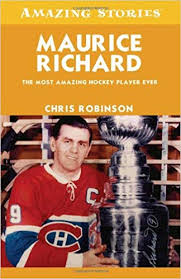 Maurice Richard
Maurice Richard
The Most Amazing Hockey Player Ever
by Chris Robinson Lorimer, 2011
ISBN 9781552779002 (sc)
$9.95, 128 pp, index, bibliography, b/w photos, ages 10+
www.lorimer.ca
“Richard might not have been the most talented man on the ice during his years in the NHL. But he certainly made himself a force to be reckoned with. Through his sheer will and determination, he made himself the best player on the ice. The clutch player. The one you knew you could count on.” (page 108
) In my part of Canada, the name Maurice Richard is legendary. It invokes history, tradition, pride and hockey in all its glory and metaphors. A new take on this historic figure is both welcome and read with trepidation. Will this book meet the challenge? Chris Robinson, author of Ottawa Senators: Great Stories from the NHL’s First Dynasty, has taken an interesting path and decided that this story must be told within its social context. So, this is not just a biography but also a history and a social commentary on these turbulent times in Québec.
The story starts with the end, the day the last game was played in the Forum, the home of the Montreal Canadiens. There we meet Maurice Richard and are introduced to the spectators’ adoring reaction that he inspired. The seven chapters that follow give us a history of the Montreal Canadiens, the role he played in saving the team from oblivion, why he was a controversial figure both on and off the ice, and how his presence changed the way this team functions and is managed within the context of the new realities and political scene in Québec. The story ends with another tribute to the famous Number 9. Who has not seen or read The Hockey Sweater, by Roch Carrier? A fitting closure that brings out the beginning of a love affair that is still happening here. And, yes, it has succeeded.
Classroom Connections: History tends to be viewed as a dusty subject. Here is a book that helps put life on the topic of “Québec – the second half of the 20th Century” into a more passionate and digestible format. But what seems to be missing would actually make a great student activity. In the age of Twitter, our students need short digestible tables and timelines, and what better exercise to show one’s comprehension, sequencing and transformational skills than by producing timelines, or Tweets that some of the personalities featured in this book could have written if they were able to?
The quote at the beginning of this review is a great introduction to the topic of “What makes a hero?” and having the students find the supporting evidence would also be an interesting exercise.
Review by Mary Moroska.
This review is from Canadian Teacher Magazine’s Sept/Oct 2012 issue.









